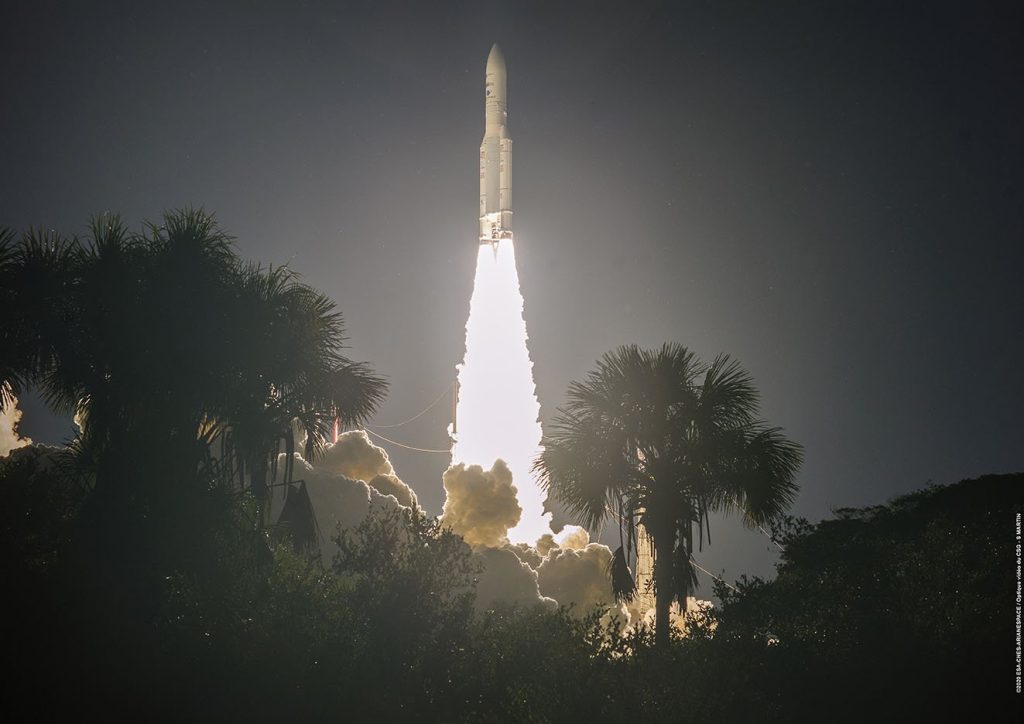
In an important prelude to the James Webb Space Telescope launch, planned for no earlier than mid-December, the Ariane 5 rocket has made its second flight of 2021 and its 111th mission overall with the VA255 flight to take two communication satellites into a geostationary transfer orbit.
Liftoff from ELA-3 at the Guiana Space Centre near Kourou, French Guiana, occurred on Saturday, October 23, at 10:10 pm EDT (02:10 UTC on Sunday, October 24) in the middle of a 2 hour 29 minute launch window that extended until 11:30 pm EDT (03:30 UTC).
The Payload
With the performance capability of the Ariane 5, the launcher — unlike others — is capable of lofting two large satellites into a geostationary transfer orbit (GTO) trajectory at the same time.
This is accomplished with the use of SYLDA (Système de Lancement Double Ariane), a cylindrical adapter that allows one satellite to ride inside SYLDA while the other rides atop it.
The upper payload is deployed first, followed by SYLDA jettison to expose the lower payload — referred to as a “passenger” by Arianespace — before it, too, is released into its needed GTO trajectory.
For the VA255 mission, SES-17 rode in the upper position, and deploy first — after the rocket’s upper stage completed the orbit insertion process approximately 25 minutes after liftoff.
SYRACUSE 4A then separated last.
SES-17
SES-17 is a 6,411-kilogram telecommunications satellite that will serve the Atlantic, Caribbean, and Americas from geostationary orbit. Built by Thales Alenia Space, the satellite uses Ka-band frequencies and contains SES’s first digital payload while featuring nearly 200 spot beams — each of which can be adjusted to meet real-time requirements.
SES-17’s services will primarily be used by the aviation, maritime, and government sectors. Based on the all-electric Spacebus NEO200 platform, its solar arrays provide up to 15 kilowatts of power while the entire satellite is designed for 15 years of service.
The Spacebus NEO200 platform contains the 5th generation Digital Transparent Processor (DTP) from Thales Alenia Space. The first of its kind to fly on an SES satellite, the DTP will enable quick and efficient frequency changes and unlimited gateway switching and traffic routing.
Another feature of SES-17 is a new mechanically pumped loop cooling system to transport heat to the spacecraft’s radiators. The first of its kind to be used on a large communications satellite, the loop replaces the traditional heat pipe cooling system that has reached its limit for satellites of this size.
Overall, SES-17 was the 42nd SES satellite and the 164th Thales Alenia Space satellite to be launched by Arianespace.
SYRACUSE 4A
The SYRACUSE 4A military communications satellite has a launch mass of 3,852 kilograms and will support French and NATO (North Atlantic Treaty Organization) military operations with Ka- and X-band secure, jamming resistant communications.
SYRACUSE 4A is the first of two SYRACUSE 4 satellites, the other being SYRACUSE 4B, contracted by the French Armament General Directorate to replace the SYRACUSE 3 satellites launched in the mid-2000s.
The new generation of SYRACUSE 4 sentinels will add capabilities to the network. The satellites are built by Thales Alenia and are designed to serve for at least 15 years
SYRACUSE 4A is based on the Spacebus NEO 100 platform from Thales Alenia Space while its sister satellite, SYRACUSE 4B, will be based on the Airbus Defence and Space Eurostar-3000EOR bus.
The payloads and instruments for both satellites are provided by Thales Alenia Space.
The SYRACUSE 4 satellite line was developed in cooperation with CNES (centre national d’études spatiales) and the Space Command of the French Air and Space Force. It was the 165th Thales Alenia Space satellite and the 46th French satellite launched by Arianespace.
The flight
The mission marked the heaviest payload for the rocket at 11.2 metric tons.
After fueling and final polling were complete, the rocket entered the terminal count at T-7 minutes, but a pressurization system reading issue in the first stage stopped the count. On the second terminal count, the sequence proceeded to the T0 mark when the first stage’s Vulcain 2 engine was commanded to ignite.
At T+7 seconds, after the Vulcain 2 engine was up and running and its health confirmed, the rocket lit its twin Solid Rocket Boosters (SRBs) — each of which provided 5,060 kN of thrust at liftoff, increasing to 7,080 kN as the stack ascended into vacuum.
The SRBs burned out and separated at T+2 minutes 18 seconds, followed by payload fairing jettison at T+3 minutes 17 seconds.
The fairing separation sequence was a critical part of the mission and serveed as a second confirmation that a rework to their separation design was indeed working as planned after back-to-back issues in mid-2020 grounded the launcher for a year.
For the VA255 mission, the first stage of the Ariane 5 completed its job at T+8 minutes 44 seconds. The ESC-A (Étage Supérieur Cryotechnique – A) then ignited shortly afterward to complete the insertion into the desired GTO trajectory.
This burn ended 25 minutes after liftoff and placed the satellites into a 250 x 35,200 km orbit inclined 6 degrees to the equator.
Payload deployment followed at T+29 minutes 35 seconds for SES-17, T+36 minutes 20 seconds for the SYLDA adaptor, and T+38 minutes 41 seconds for SYRACUSE 4A.
SES-17 and SYRACUSE 4A will use their propellants and engines to raise their orbits to their final geostationary targets.





























